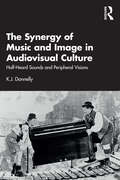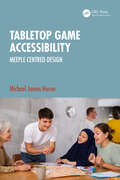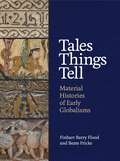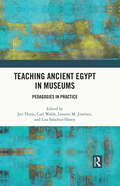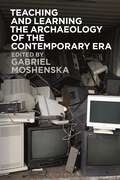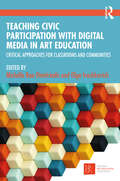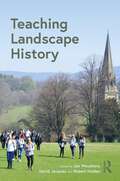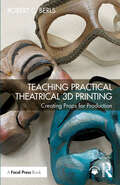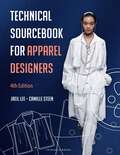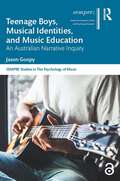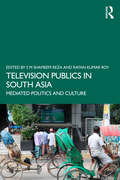- Table View
- List View
The Synergy of Music and Image in Audiovisual Culture: Half-Heard Sounds and Peripheral Visions
by K.J. DonnellyThe Synergy of Music and Image in Audiovisual Culture: Half-Heard Sounds and Peripheral Visions asks what it means to understand music as part of an audiovisual whole, rather than separate components of music and film. Bringing together revised and updated essays on music in a variety of media – including film, television, and video games – this book explores the importance of partially perceived and registered auditory and visual elements and cultural context in creating unique audiovisual experiences. Critiquing traditional models of the film score, The Synergy of Music and Image in Audiovisual Culture enables readers across music, film, and cultural studies to approach and think about audiovisual culture in new ways.
The Synergy of Music and Image in Audiovisual Culture: Half-Heard Sounds and Peripheral Visions
by K.J. DonnellyThe Synergy of Music and Image in Audiovisual Culture: Half-Heard Sounds and Peripheral Visions asks what it means to understand music as part of an audiovisual whole, rather than separate components of music and film. Bringing together revised and updated essays on music in a variety of media – including film, television, and video games – this book explores the importance of partially perceived and registered auditory and visual elements and cultural context in creating unique audiovisual experiences. Critiquing traditional models of the film score, The Synergy of Music and Image in Audiovisual Culture enables readers across music, film, and cultural studies to approach and think about audiovisual culture in new ways.
Tabletop Game Accessibility: Meeple Centred Design
by Michael James HeronThis foundational resource on the topic of tabletop game accessibility provides actionable guidelines on how to make games accessible for people with disabilities. This book contextualises this practical guidance within a philosophical framework of how the relatively abled can ethically address accessibility issues within game design.This book helps readers to build understanding and empathy across the various categories of accessibility. Chapters on each category introduce ‘the science’, outline the game mechanics and games that show exemplar problems, relate these to the real-world situations that every player may encounter, and then discuss how to create maximally accessible games with reference to the accessibility guidelines and specific games that show ‘best-in-class’ examples of solutions.This book will be of great interest to all professional tabletop and board game designers as well as digital game designers and designers of other physical products.
Tabletop Game Accessibility: Meeple Centred Design
by Michael James HeronThis foundational resource on the topic of tabletop game accessibility provides actionable guidelines on how to make games accessible for people with disabilities. This book contextualises this practical guidance within a philosophical framework of how the relatively abled can ethically address accessibility issues within game design.This book helps readers to build understanding and empathy across the various categories of accessibility. Chapters on each category introduce ‘the science’, outline the game mechanics and games that show exemplar problems, relate these to the real-world situations that every player may encounter, and then discuss how to create maximally accessible games with reference to the accessibility guidelines and specific games that show ‘best-in-class’ examples of solutions.This book will be of great interest to all professional tabletop and board game designers as well as digital game designers and designers of other physical products.
Tales Things Tell: Material Histories of Early Globalisms
by Finbarr Barry Flood Beate FrickeNew perspectives on early globalisms from objects and imagesTales Things Tell offers new perspectives on histories of connectivity between Africa, Asia, and Europe in the period before the Mongol conquests of the thirteenth century. Reflected in objects and materials whose circulation and reception defined aesthetic, economic, and technological networks that existed outside established political and sectarian boundaries, many of these histories are not documented in the written sources on which historians usually rely. Tales Things Tell charts bold new directions in art history, making a compelling case for the archival value of mobile artifacts and images in reconstructing the past.In this beautifully illustrated book, Finbarr Barry Flood and Beate Fricke present six illuminating case studies from the sixth to the thirteenth centuries to show how portable objects mediated the mobility of concepts, iconographies, and techniques. The case studies range from metalwork to stone reliefs, manuscript paintings, and objects using natural materials such as coconut and rock crystal. Whether as booty, commodities, gifts, or souvenirs, many of the objects discussed in Tales Things Tell functioned as sources of aesthetic, iconographic, or technical knowledge in the lands in which they came to rest. Remapping the histories of exchange between medieval Islam and Christendom, from Europe to the Indian Ocean, Tales Things Tell ventures beyond standard narratives drawn from written archival records to demonstrate the value of objects and images as documents of early globalisms.
Tales Things Tell: Material Histories of Early Globalisms
by Finbarr Barry Flood Beate FrickeNew perspectives on early globalisms from objects and imagesTales Things Tell offers new perspectives on histories of connectivity between Africa, Asia, and Europe in the period before the Mongol conquests of the thirteenth century. Reflected in objects and materials whose circulation and reception defined aesthetic, economic, and technological networks that existed outside established political and sectarian boundaries, many of these histories are not documented in the written sources on which historians usually rely. Tales Things Tell charts bold new directions in art history, making a compelling case for the archival value of mobile artifacts and images in reconstructing the past.In this beautifully illustrated book, Finbarr Barry Flood and Beate Fricke present six illuminating case studies from the sixth to the thirteenth centuries to show how portable objects mediated the mobility of concepts, iconographies, and techniques. The case studies range from metalwork to stone reliefs, manuscript paintings, and objects using natural materials such as coconut and rock crystal. Whether as booty, commodities, gifts, or souvenirs, many of the objects discussed in Tales Things Tell functioned as sources of aesthetic, iconographic, or technical knowledge in the lands in which they came to rest. Remapping the histories of exchange between medieval Islam and Christendom, from Europe to the Indian Ocean, Tales Things Tell ventures beyond standard narratives drawn from written archival records to demonstrate the value of objects and images as documents of early globalisms.
Teaching Ancient Egypt in Museums: Pedagogies in Practice
by Jen Thum Carl Walsh Lissette M. Jiménez Lisa Saladino HaneyTeaching Ancient Egypt in Museums: Pedagogies in Practice explores what best practices in museum pedagogy look like when working with ancient Egyptian material culture. The contributions within the volume reflect the breadth and collaborative nature of museum learning. They are written by Egyptologists, teachers, curators, museum educators, artists, and community partners working in a variety of institutions around the world—from public, children’s, and university museums, to classrooms and the virtual environment—who bring a broad scope of expertise to the conversation and offer inspiration for tackling a diverse range of challenges. Contributors foreground their first-hand experiences, pedagogical justifications, and reflective teaching practices, offering practical examples of ethical and equitable teaching with ancient Egyptian artifacts. Teaching Ancient Egypt in Museums serves as a resource for teaching with Egyptian collections at any museum, and at any level. It will also be of great interest to academics and students who are engaged in the study of museums, ancient Egypt, anthropology, and education.
Teaching Ancient Egypt in Museums: Pedagogies in Practice
Teaching Ancient Egypt in Museums: Pedagogies in Practice explores what best practices in museum pedagogy look like when working with ancient Egyptian material culture. The contributions within the volume reflect the breadth and collaborative nature of museum learning. They are written by Egyptologists, teachers, curators, museum educators, artists, and community partners working in a variety of institutions around the world—from public, children’s, and university museums, to classrooms and the virtual environment—who bring a broad scope of expertise to the conversation and offer inspiration for tackling a diverse range of challenges. Contributors foreground their first-hand experiences, pedagogical justifications, and reflective teaching practices, offering practical examples of ethical and equitable teaching with ancient Egyptian artifacts. Teaching Ancient Egypt in Museums serves as a resource for teaching with Egyptian collections at any museum, and at any level. It will also be of great interest to academics and students who are engaged in the study of museums, ancient Egypt, anthropology, and education.
Teaching and Learning the Archaeology of the Contemporary Era
by Gabriel MoshenskaThe tools and techniques of archaeology were designed for the study of past people and societies, but for more than a century a growing number of archaeologists have turned these same tools to the study of the modern world. This book offers an overview of these pioneering practices through a specifically pedagogical lens, fostering an appreciation of the diversity and distinctiveness of contemporary archaeology and providing an evidence base for course proposals and curriculum design.Although research in the field is well established and vibrant, making critical contributions to wider debates around issues such as homelessness, migration and the refugee crisis, and legacies of war and conflict, the teaching of contemporary archaeology in universities has until recently been relatively limited in comparison. This selection of carefully curated case studies from as far afield as Orkney, Iran and the USA is intended as a resource and an inspiration for both teachers and students, presenting a set of tools and practices to borrow, modify and apply in new contexts. It demonstrates how interdisciplinarity, practical work and radical pedagogies are of value not only for archaeology, but also for fields such as history, geography and anthropology, and suggests new ways in which we can examine our 20th- and 21st-century existence and shape our collective future.
Teaching Architecture: The New Age of Digital Design (Routledge Focus on Design Pedagogy)
In the post-COVID era, understanding the profound impact of digital technologies on design pedagogy is crucial. This book delves into experimental design education, showcasing projects utilising technology to transform creative and analytical processes.Emphasising the potential for digital-era technologies to create novel educational opportunities, the book addresses recent global events and their role in minimising educational disruptions in the evolving hybrid educational landscape. Each chapter offers case studies exploring digital technology's influence across architectural education, spanning interior design, urban planning, parametric digital design, architectural conservation, and design analysis. Contributors envision the hybrid virtual design studio’s future and discuss the collaborative role of digital technologies in urban design projects. The book analyses contemporary parametric design processes and machine learning through innovative historical case studies, examining new technologies in architectural conservation.With case studies from diverse locations, including South Africa, Turkey, the UK, and the United States, the book provides a global perspective on the influences and potential futures of digital technologies in architecture. Essential for those interested in the future of spatial design education, this book illuminates the pivotal role of technology in shaping its trajectory.
Teaching Architecture: The New Age of Digital Design (Routledge Focus on Design Pedagogy)
by Sadiyah GeyerIn the post-COVID era, understanding the profound impact of digital technologies on design pedagogy is crucial. This book delves into experimental design education, showcasing projects utilising technology to transform creative and analytical processes.Emphasising the potential for digital-era technologies to create novel educational opportunities, the book addresses recent global events and their role in minimising educational disruptions in the evolving hybrid educational landscape. Each chapter offers case studies exploring digital technology's influence across architectural education, spanning interior design, urban planning, parametric digital design, architectural conservation, and design analysis. Contributors envision the hybrid virtual design studio’s future and discuss the collaborative role of digital technologies in urban design projects. The book analyses contemporary parametric design processes and machine learning through innovative historical case studies, examining new technologies in architectural conservation.With case studies from diverse locations, including South Africa, Turkey, the UK, and the United States, the book provides a global perspective on the influences and potential futures of digital technologies in architecture. Essential for those interested in the future of spatial design education, this book illuminates the pivotal role of technology in shaping its trajectory.
Teaching Civic Participation with Digital Media in Art Education: Critical Approaches for Classrooms and Communities
by Michelle Bae-Dimitriadis Olga IvashkevichThis anthology shares educational practices to engage young people in critical digital media consumption and production. Comprehensive frameworks and teaching guidance enable educators to empower students to use digital technologies to respond to the social, political, economic, and other critical issues in their real-life and online communities. Section I of the book explores philosophical and conceptual approaches to teaching civic participation via digital media and technologies in various educational settings, Section II focuses on the participatory civic approaches in K-16 art education classrooms, and Section III outlines these approaches for arts-based community settings (after school programs, camps, online sites). Throughout, authors reference different technologies – video, digital collage, glitch, game design, mobile applications, virtual reality, and social media – and offer in-depth discussions of pedagogical processes and exemplary curriculum projects. Building on National (NAEA) and State Media Arts Standards, the educational practices outlined facilitate students’ media literacy skills and digital citizenship awareness in the art classroom and provide a solid foundation for teaching civic-minded media making. Ideal for art and media educators within preservice and higher education spaces, this book equips readers to prepare their students to be thoughtful and critical producers of their own media that can effectively advocate for social change.
Teaching Civic Participation with Digital Media in Art Education: Critical Approaches for Classrooms and Communities
by Michelle Bae-Dimitriadis Olga IvashkevichThis anthology shares educational practices to engage young people in critical digital media consumption and production. Comprehensive frameworks and teaching guidance enable educators to empower students to use digital technologies to respond to the social, political, economic, and other critical issues in their real-life and online communities. Section I of the book explores philosophical and conceptual approaches to teaching civic participation via digital media and technologies in various educational settings, Section II focuses on the participatory civic approaches in K-16 art education classrooms, and Section III outlines these approaches for arts-based community settings (after school programs, camps, online sites). Throughout, authors reference different technologies – video, digital collage, glitch, game design, mobile applications, virtual reality, and social media – and offer in-depth discussions of pedagogical processes and exemplary curriculum projects. Building on National (NAEA) and State Media Arts Standards, the educational practices outlined facilitate students’ media literacy skills and digital citizenship awareness in the art classroom and provide a solid foundation for teaching civic-minded media making. Ideal for art and media educators within preservice and higher education spaces, this book equips readers to prepare their students to be thoughtful and critical producers of their own media that can effectively advocate for social change.
Teaching Labor History in Art and Design: Capitalism and the Creative Industries (Routledge Studies in Education, Neoliberalism, and Marxism)
by Kyunghee Pyun Vincent G. QuanDrawing from American history, fashion design, history of luxury, visual culture, museum studies, and women’s history, among others, this book explores the challenges, rewards and benefits of teaching business and the labor history of art and design professions to those in higher education.Recognizing that artists and designers are no longer just creatives, but bosses, employees, members of professional associations, and citizens of nations that encourage and restrain their creative work in various ways, the book identifies a crucial need for art and design students to be taught the intricacies of these other roles, as well as how to navigate or challenge them. This empirically driven study features case studies in various pedagogical contexts, including museum exhibitions, group projects, lesson plans, discussion topics, and long-term assignments. The chapters also explore how the roles of designing and making became separated, how new technologies and the rise of mass production affected creative careers, the shifts back and forth between direct employment and freelancing, and the evolution of government interventions in creative fields.With a diverse and experienced range of contributors, and providing a unique set of conceptual tools to interpret, cope with, and react to the ever-changing conditions of capitalism, this volume will appeal to educators and researchers across education, history, art history, and sociology, with interests in experiential learning, capitalism, equity, social justice and neoliberalism.
Teaching Labor History in Art and Design: Capitalism and the Creative Industries (Routledge Studies in Education, Neoliberalism, and Marxism)
Drawing from American history, fashion design, history of luxury, visual culture, museum studies, and women’s history, among others, this book explores the challenges, rewards and benefits of teaching business and the labor history of art and design professions to those in higher education.Recognizing that artists and designers are no longer just creatives, but bosses, employees, members of professional associations, and citizens of nations that encourage and restrain their creative work in various ways, the book identifies a crucial need for art and design students to be taught the intricacies of these other roles, as well as how to navigate or challenge them. This empirically driven study features case studies in various pedagogical contexts, including museum exhibitions, group projects, lesson plans, discussion topics, and long-term assignments. The chapters also explore how the roles of designing and making became separated, how new technologies and the rise of mass production affected creative careers, the shifts back and forth between direct employment and freelancing, and the evolution of government interventions in creative fields.With a diverse and experienced range of contributors, and providing a unique set of conceptual tools to interpret, cope with, and react to the ever-changing conditions of capitalism, this volume will appeal to educators and researchers across education, history, art history, and sociology, with interests in experiential learning, capitalism, equity, social justice and neoliberalism.
Teaching Landscape History
Landscape history is changing in content and style to address the issues of today. Experienced teachers and authors on the history of gardens and landscapes come together in this new volume to share ideas on the future of teaching history in departments of landscape architecture, archaeology, geography and allied subjects. Design history remains important, but this volume brings to the fore the increasing importance of environmental history, economic history, landscape history, cultural landscapes, environmental justice and decolonisation, ideas of sustainability and climate change amelioration, which may all be useful in serving the needs of a widening range of students in an increasingly complex world. The main themes include: what history should we narrate in the education of landscape architects? how can we recognise counter-narratives and our own bias? how should we engage the students in the history of their chosen profession? how can designers and researchers be persuaded of the relevance of history teaching to theory and practice? and what resources do we need to develop teaching of landscape histories? This book will be of interest to anyone teaching courses on landscape architecture, urban design, horticulture, garden design, architectural history, cultural geography and more.
Teaching Landscape History
by Jan Woudstra David JacquesLandscape history is changing in content and style to address the issues of today. Experienced teachers and authors on the history of gardens and landscapes come together in this new volume to share ideas on the future of teaching history in departments of landscape architecture, archaeology, geography and allied subjects. Design history remains important, but this volume brings to the fore the increasing importance of environmental history, economic history, landscape history, cultural landscapes, environmental justice and decolonisation, ideas of sustainability and climate change amelioration, which may all be useful in serving the needs of a widening range of students in an increasingly complex world. The main themes include: what history should we narrate in the education of landscape architects? how can we recognise counter-narratives and our own bias? how should we engage the students in the history of their chosen profession? how can designers and researchers be persuaded of the relevance of history teaching to theory and practice? and what resources do we need to develop teaching of landscape histories? This book will be of interest to anyone teaching courses on landscape architecture, urban design, horticulture, garden design, architectural history, cultural geography and more.
Teaching Practical Theatrical 3D Printing: Creating Props for Production
by Robert C. BerlsTeaching Practical Theatrical 3D Printing: Creating Props for Production is a cohesive and practical guide for instructors teaching 3D printing techniques in stagecraft, costume and props courses.Written for the instructor, this book uses non-technical language to explain 3D printers, their workflows and products. Coverage includes the ins and outs of multiple filaments, pros and cons of different types of printers, shop or laboratory setup and safety concerns. The book features lesson plans, rubrics and class-tested sample student projects from design to finished product that highlight learning objectives and methodologies, as well as software and hardware usage explanations and common problems that can occur within design and printing. Step-by-step instructions are included for many types of projects, including fake noses, candlestick phones, buttons, 3D scans, historical recreations and linear actuators. The book also contains examples of poor, average and excellent work with grading explanations and guidance on how to help the student move to the next level with their projects. Chapter objectives, chapter summaries, checklists and reflection points facilitate an instructor in gaining confidence with 3D printers and incorporating their use in the classroom.Teaching Practical Theatrical 3D Printing is an excellent resource for instructors of Props and Costume Design and Construction courses that are interested in using state of the art tools and technology for theatre production.Fully editable files for every object featured in the book are available at www.routledge.com/9781032453279, allowing readers to jump-start their projects and giving them the flexibility to change and redesign the items to best fit their needs.
Teaching Practical Theatrical 3D Printing: Creating Props for Production
by Robert C. BerlsTeaching Practical Theatrical 3D Printing: Creating Props for Production is a cohesive and practical guide for instructors teaching 3D printing techniques in stagecraft, costume and props courses.Written for the instructor, this book uses non-technical language to explain 3D printers, their workflows and products. Coverage includes the ins and outs of multiple filaments, pros and cons of different types of printers, shop or laboratory setup and safety concerns. The book features lesson plans, rubrics and class-tested sample student projects from design to finished product that highlight learning objectives and methodologies, as well as software and hardware usage explanations and common problems that can occur within design and printing. Step-by-step instructions are included for many types of projects, including fake noses, candlestick phones, buttons, 3D scans, historical recreations and linear actuators. The book also contains examples of poor, average and excellent work with grading explanations and guidance on how to help the student move to the next level with their projects. Chapter objectives, chapter summaries, checklists and reflection points facilitate an instructor in gaining confidence with 3D printers and incorporating their use in the classroom.Teaching Practical Theatrical 3D Printing is an excellent resource for instructors of Props and Costume Design and Construction courses that are interested in using state of the art tools and technology for theatre production.Fully editable files for every object featured in the book are available at www.routledge.com/9781032453279, allowing readers to jump-start their projects and giving them the flexibility to change and redesign the items to best fit their needs.
Technical Sourcebook for Apparel Designers: - with STUDIO
by Jaeil Lee Camille SteenLearn technical design processes and industry standards, such as ASTM and ISO, for apparel production and manufacturing practices. With more than 1,200 images and technical packages for 12 apparel products, the book explains topics like fabric selection, finding seasonal fashion trends, garment construction, and fit evaluation, all so you can cost-effectively meet consumer needs. You'll learn about product categories including women's wear, menswear, and knitwear, as well as how to create a cost sheet and manage product data, to help you develop specification sheets and technical packages for specific markets. The 4th edition has been revised to include the use of sustainable materials, entrepreneurship and the job market, buying seasons as affected by the Covid-19 pandemic and supply chain, sourcing considerations, sizing and fit tips for diverse body types, and more. New to this Edition· Includes new information on sustainability and sourcing · Discusses changes in buying seasons as affected by the Covid-19 pandemic· Delves into the job market, job roles, and entrepreneurship · Updated to include sizing and fit tips for diverse body types STUDIO Features Include· Study smarter with self-quizzes featuring scored results and personalized study tips· Review concepts with flashcards of terms and definitionsInstructor Resources· Instructor's Guide to help integrate the text into your classroom· PowerPoint slides for every chapter
Technology, Intellectual Property Law and Culture: The Tangification of Intangible Cultural Heritage
by Megan Rae BlakelyFocusing on cultural expressions that are most likely to intermingle with copyright law, trademark and IP-adjacent regulations, this book examines contemporary issues in technology, intellectual property law, and culture.Intangible Cultural Heritage can consist of traditional knowledge, songs, craftsmanship, dance, and other practices, as well as the associated cultural artefacts and spaces; a widely varied global living heritage, transmitted generationally, must be allowed to organically evolve, often defying the process of identification so desirable in the realm of legal protections. This nebulous essence is particularly ill-suited to modern legal frameworks that can conflate the creative outputs that copyright is meant to protect with shared cultural practices. Combining a legal perspective with historical tact, the book develops a theoretical model to track the interaction amongst these issues as well as to make policy recommendations based on the existing and projected possible future outcomes. Several chapters of the book will be dedicated to contemporary issues where this framework and interaction are currently developing, focussing on law and technology issues with archiving and museums, online platforms and copyright infringement, and communities and creative production in virtual worlds.The book will be of interest to students and scholars in the field of copyright law and intellectual property law.
Technology, Intellectual Property Law and Culture: The Tangification of Intangible Cultural Heritage
by Megan Rae BlakelyFocusing on cultural expressions that are most likely to intermingle with copyright law, trademark and IP-adjacent regulations, this book examines contemporary issues in technology, intellectual property law, and culture.Intangible Cultural Heritage can consist of traditional knowledge, songs, craftsmanship, dance, and other practices, as well as the associated cultural artefacts and spaces; a widely varied global living heritage, transmitted generationally, must be allowed to organically evolve, often defying the process of identification so desirable in the realm of legal protections. This nebulous essence is particularly ill-suited to modern legal frameworks that can conflate the creative outputs that copyright is meant to protect with shared cultural practices. Combining a legal perspective with historical tact, the book develops a theoretical model to track the interaction amongst these issues as well as to make policy recommendations based on the existing and projected possible future outcomes. Several chapters of the book will be dedicated to contemporary issues where this framework and interaction are currently developing, focussing on law and technology issues with archiving and museums, online platforms and copyright infringement, and communities and creative production in virtual worlds.The book will be of interest to students and scholars in the field of copyright law and intellectual property law.
Teenage Boys, Musical Identities, and Music Education: An Australian Narrative Inquiry (ISSN)
by Jason GoopyMusic is a powerful process and resource that can shape and support who we are and wish to be. The interaction between musical identities and learning music highlights school music education’s potential contributions and responsibilities, especially in supporting young people’s mental health and well-being. Through the distinctive stories and drawings of Aaron, Blake, Conor, Elijah, Michael, and Tyler, this book reveals the musical identities of teenage boys in their final year of study at an Australian boys’ school.This text serves as an interface between music, education, and psychology using narrative inquiry. Previous research in music education often seeks to generalise boys, whereas this study recognises and celebrates the diverse individual voices of students where music plays a significant role in their lives. Adolescent boys’ musical identities are examined using the theories of identity work and possible selves, and their underlying music values and uses are considered important guiding principles and motivating goals in their identity construction. A teaching and learning framework to shape and support multiple musical identities in senior secondary class music is presented.The relatable and personal stories in this book will appeal to a broad readership, including music teachers, teacher educators, researchers, and readers interested in the role of music in our lives. Creative and arts-based research methods, including narrative inquiry and innovative draw and tell interviews, will be particularly relevant for research method courses and postgraduate research students.
Teenage Boys, Musical Identities, and Music Education: An Australian Narrative Inquiry (ISSN)
by Jason GoopyMusic is a powerful process and resource that can shape and support who we are and wish to be. The interaction between musical identities and learning music highlights school music education’s potential contributions and responsibilities, especially in supporting young people’s mental health and well-being. Through the distinctive stories and drawings of Aaron, Blake, Conor, Elijah, Michael, and Tyler, this book reveals the musical identities of teenage boys in their final year of study at an Australian boys’ school.This text serves as an interface between music, education, and psychology using narrative inquiry. Previous research in music education often seeks to generalise boys, whereas this study recognises and celebrates the diverse individual voices of students where music plays a significant role in their lives. Adolescent boys’ musical identities are examined using the theories of identity work and possible selves, and their underlying music values and uses are considered important guiding principles and motivating goals in their identity construction. A teaching and learning framework to shape and support multiple musical identities in senior secondary class music is presented.The relatable and personal stories in this book will appeal to a broad readership, including music teachers, teacher educators, researchers, and readers interested in the role of music in our lives. Creative and arts-based research methods, including narrative inquiry and innovative draw and tell interviews, will be particularly relevant for research method courses and postgraduate research students.
Television Publics in South Asia: Mediated Politics and Culture
by S.M. Shameem Reza and Ratan Kumar RoyTelevision has a prime role to play in the formation of discursive domains in the everyday life of South Asian publics. This book explores various television media practices, social processes, mediated political experiences and everyday cultural compositions from Afghanistan, Bangladesh, India, Nepal, Pakistan and Sri Lanka. With the help of country specific case studies, it captures broad range of themes which foreground the publics and their real-life experiences of television in the region. The essays in this book discuss gendered television spaces; women seeking solace from television in pandemic; the taboo in digital tv dramas; television viewership and localizing publics; changing viewership from television to OTT; news and public perception of death; re-defining ‘the national’; theatrical television; and post truth television news, among other key issues. Rich in ethnographic case studies, this volume will be a useful resource for scholars and researchers of media and communication studies, journalism, digital media, South Asian studies, cultural studies, sociology and social anthropology.
